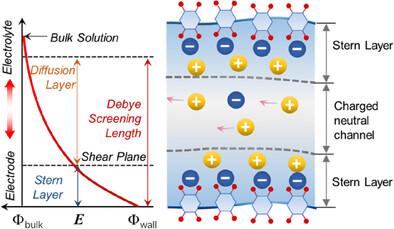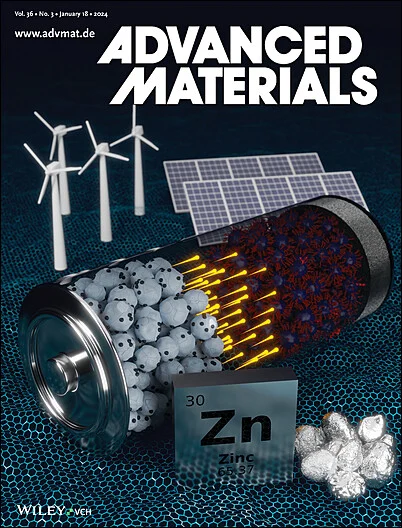IF 27.4
1区 材料科学
Q1 CHEMISTRY, MULTIDISCIPLINARY
引用次数: 0
摘要
锌金属电池的商业化旨在实现高倍率能力和轻量化,这就要求锌阳极在高电流密度、高面积容量和高放电深度下工作。然而,频繁出现的锌阳极在极端条件下会急剧褪色。本文揭示了阳极不稳定的主要原因是极端条件下 Zn2+ 的消耗率和转移率不平衡导致的严重浓度极化。基于这一发现,我们构建了一个纳米流体层,以快速吸收 Zn2+,并缓解界面离子非线性传输所引起的极化。改进后的锌阳极在极端条件下可维持超过 1573 小时(40 mA cm-2、40 mAh cm-2、DOD = 75.97%)和 490 小时(100 mA cm-2、100 mAh cm-2、DOD = 90.91%),并实现了前所未有的 62.92 Ah cm-2 的累积容量。这项研究为储能设备的接口设计提供了基础性和实用性的启示。本文章由计算机程序翻译,如有差异,请以英文原文为准。

Elimination of Concentration Polarization Under Ultra-High Current Density Zinc Deposition by Nanofluid Self-Driven Ion Enrichment
The commercialization of zinc metal batteries aims at high-rate capability and lightweight, which requires zinc anodes working at high current density, high areal capacity, and high depth of discharge. However, frequent zinc anode fades drastically under extreme conditions. Herein, it is revealed that the primary reason for the anode instability is the severe concentration polarization caused by the imbalanced consumption rate and transfer rate of Zn2+ under extreme conditions. Based on this finding, a nanofluid layer is constructed to rapidly absorb Zn2+ and mitigate the polarization induced by the nonlinear transport of interfacial ions. The modified zinc anode sustains at extreme conditions for over 1573 h (40 mA cm−2, 40 mAh cm−2, DOD = 75.97%) and 490 h (100 mA cm−2, 100 mAh cm−2, DOD = 90.91%), and achieving an unprecedented cumulative capacity of 62.92 Ah cm−2. This work offers both fundamental and practical insights for the interface design in energy storage devices.
求助全文
通过发布文献求助,成功后即可免费获取论文全文。
去求助
来源期刊

Advanced Materials
工程技术-材料科学:综合
CiteScore
43.00
自引率
4.10%
发文量
2182
审稿时长
2 months
期刊介绍:
Advanced Materials, one of the world's most prestigious journals and the foundation of the Advanced portfolio, is the home of choice for best-in-class materials science for more than 30 years. Following this fast-growing and interdisciplinary field, we are considering and publishing the most important discoveries on any and all materials from materials scientists, chemists, physicists, engineers as well as health and life scientists and bringing you the latest results and trends in modern materials-related research every week.
 求助内容:
求助内容: 应助结果提醒方式:
应助结果提醒方式:


